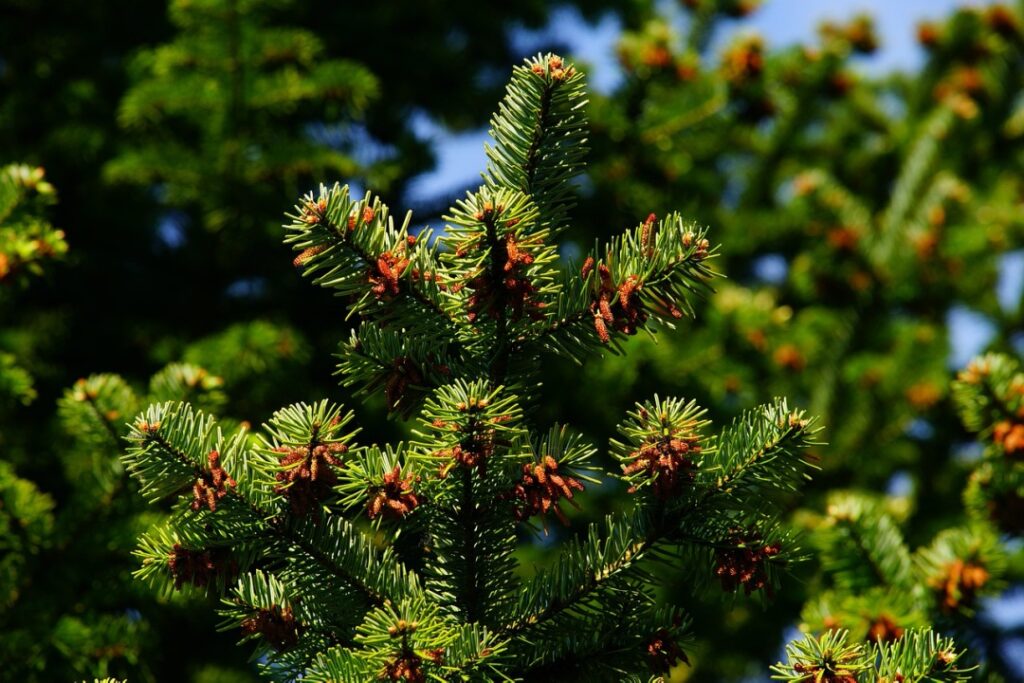
United States of America
Pine
Pinus

General Description / Cultural Significance
Pine trees and Pine forests of the pinus genus are central to the United States national story. When European settlers arrived, they discovered vast areas of virgin evergreen pine forests covering the East Coast. The trees admitted a purifying fragrance that had a profound effect on the settlers. The scent they said was so beautiful they compared it to frankincense, Boswellia sacra. The new Americans adopted this scent as the olfactory standard of freshness, cleanliness, and good health. It was the smell of the New World.
Pine species were already culturally embedded in the lives and spiritual beliefs of the first people of the region. Many tribes passed down their knowledge of pine virtues as food, medicine, lumber, fuel, pitch, rosin, and tar, ensuring the settlers’ survival, and from this tree, homes, churches, towns, and cities were built. Utensils, ship masts, and furniture was also fashioned.
Pines grow in all fifty states of The United States, and they all have a similar characteristic scent – a fresh and resinous aroma that is associated with all pines. The most common species are Eastern White Pine (P. strobus), Longleaf Pine (P. palustris), Sugar Pine (P. lambertiana), Loblolly Pine (P. taeda), Western White Pine (P. monticola), and Ponderosa Pine (P. ponderosa). Pines are endowed with a broad spectrum of bioactive substances that have played a role in healing since the earliest inhabitants of the continent. Since the 1800s, American Christians have associated the scent of pine with the joyful tradition of bringing a fresh-cut pine tree into the home at Christmas time.
Climate Change / Conservation Status
While historically most of the death of pine trees was a result of colonizers and the foresting industry, climate change is now a much deadlier threat. Across every state, climate change conditions have rendered pine trees susceptible to fungal disease and insect infestations such as Pine Beetles, which tunnel underneath the bark, disrupting the flow of nutrients and killing the tree in months. Global warming is also affecting the distribution of trees. They are on the move north and to higher elevations. Species that can exist only at higher elevations may die out because they cannot shift to a higher altitude. In study after study, researchers are lamenting the deadly effects of global warming on these species. Reduced rainfall is responsible for the mortality of many young juvenile trees; however, drought is not only responsible for pine loss. Floods in some places and high-intensity mega-fires in others, continue to destroy trees in large swathes across the country. Additionally, dying trees weakened from drought and pests have proven to raise the wildfire risk of devastating fires.
Research published in 2023 by University of Arizona scientists suggests the Ponderosa pine, one of the ubiquitous conifer species across the West Coast, is destabilized, and different populations are moving in different directions. Since the megadrought began in 2000, the atmosphere is so dry that the trees can no longer reduce their water loss by closing their stomata, the small pores on their leaves or needles. It is likely that this hydraulic failure will increase as the heat waves persist.
Pine Wilt is a fatal pathogenic disease that is widely distributed in the United States, but the highest incidence of the disease is in the Midwest. It is responsible for killing many Scots Pine, P. sylvestris at an unprecedented scale. Dead forests can be seen across mountains and landscapes throughout the country. Pine Wilt is most serious on non-native species, and many areas are voting to replace them with a different species that might be more resilient to the current conditions.
In December 2022, the U.S. Fish and Wildlife Service finally declared the Whitebark Pine threatened. The Whitebark Pine, an ancient-looking conifer that is a keystone species, lives in windy, cold, high-elevation, or high-latitude environments across the western United States and southern Canada. The five-needled pine influences the health and life cycle of other native plants and animals. In addition to providing a high-energy food source for animals, healthy Whitebark pine stands also play an essential role in slowing runoff from snowmelt and reducing soil erosion. Longleaf Pine is also endangered.
For individuals with sick pine trees, don’t hesitate to call in a certified arborist who can make a diagnosis and recommend treatment.
Reports from NOAA and the National Weather Service state that due to anthropogenic warming over the 21st century, there have been increased hurricanes and tropical storms that have swept across the South, Southwest, West Coast, and inland, with high winds and catastrophic flooding. The US has experienced over 1,000 confirmed tornadoes for the year as of August 2023, with Illinois setting the record for the most. As of August, Tornado deaths were 60 in 2023, doubling 2022. Due to the climate change effects of increased heat and extended drought, as of August 17, 2023, the CIFFC reported 36,382 fires in the US so far in 2023, which have burned over 1.68 million acres and millions of pine trees. The 2023 wildfires on Hawaii’s Maui were one the deadliest and devastated the historic city of Lahaina and the surrounding flora and fauna. As of August 8, 2023, there have been 15 confirmed extreme weather-climate disaster events with losses exceeding $1 billion each in the United States.
Sources
(2000). Pine Wilt: A Fatal Disease of Exotic Plants in the Midwest (9th ed., pp. 1-8). Iowa State University Extension and Outreach.
Brandt , R. (2023, June 7). Ponderosa forests struggle in the face of Southwest megadrought. The University of Arizona. https://news.arizona.edu/story/ponderosa-forests-struggle-face-southwest-megadrought.
This statement can be found on the World Sensorium original website.

